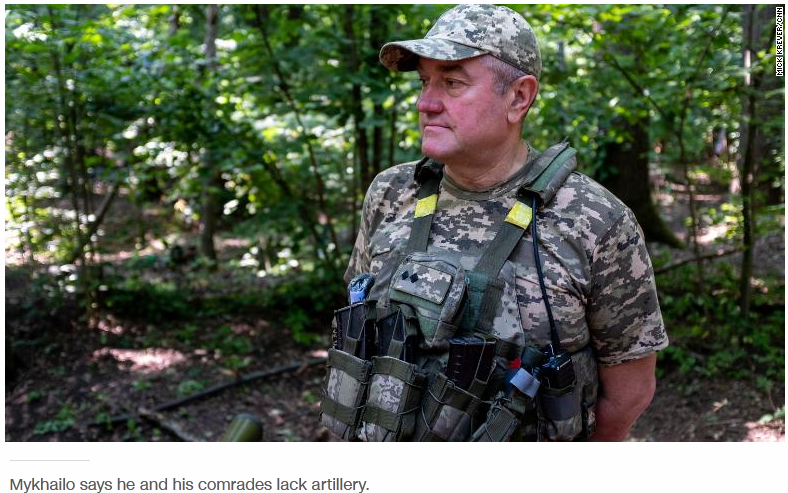
For less than a fortnight, Maxym and his friends have been sleeping in earthen dugouts, eating food heated over campfires, and hearing the news of the Russians advancing in the vicinity of just one mile. “Of course they are going to come,” he says. “They are far more numerous than we are.”
They are dug deep into this dense eastern Ukrainian forest, near Slovyansk, and are part of Ukraine’s territorial defense — non-professional soldiers who signed up in the opening days of Russia’s February invasion. So far, they have avoided contact with the enemy by hiding beneath camouflage nets next to giant pyramids of bottled water. But every moment of every day they live with the thud of artillery and are showered with cluster munitions. Their wooded encampment is regularly struck by anti-tank weapons. And though they’re well supplied with the weapons that proved so decisive in holding back Russia’s initial incursion, those are not the weapons they need at this phase of the war, says Maxym’s comrade Mykhailo (who asked to use only his first name out because he didn’t want his family to know where he was).
For every one of our heavy shots, they produce 10 or 20. It is because we do not have artillery.
The Donbas region has been a source of conflict since 2014, when pro-Russian separatists first took up arms against the Ukrainian government. After Ukraine routed Russia’s attempt to decapitate the government in Kyiv earlier this year, Donbas was once again at the center of Ukraine’s battle against its eastern neighbor. Russian forces captured the industrial city of Severodonetsk and appeared close to encircling Ukraine’s forces in neighboring Lysychansk. That puts pressure on Ukraine’s most important remaining population centers in the Donbas — Bakhmut, Slovyansk and especially Kramatorsk. The territorial defense unit is just one in a network of corks that the Ukrainian military is using to plug gaps in its defense. If and when they do have direct contact with the enemy, it will mean artillery has failed to hold back the Russian advance, and Slovyansk is in real danger. Mykhailo peers over the edge of a trench to show why his unit has been placed here; he points out that if a convoy were to come driving down this road, their task would be to stop it.’
Civilians, whose defense the civilians aim to protect, are currently, and increasingly, suffering from Russia’s advance. Rockets discharge their deadly cluster payloads over apartment buildings, supermarkets, and suburban homes. The bomblets burst through windows and entryways, and endanger any unlucky person who is caught by surprise.
Igor, in his late 30s, was one of the people killed on Monday. He got into a taxi and drove away from his first-floor apartment in a Soviet-era building. But he never made it. “I was standing here crying,” said Valentina, 76, who lives next door. “He was such a good guy. His name was Igor. And my husband’s name is Igor too.” Explosions caused by Russian bombs scattered debris over the bed where they sleep together, and now her husband—a former builder who is now retired—is sawing a piece of particle board to cover up their broken window above the front door to their building. “It’s very scary,” she says. “At night, I cover myself with a pillow.” Slovyansk experiences most of the fighting between Russia and Ukraine these days; Bakhmut gets hit hard by airstrikes from the south.
“We didn’t harm anyone,” she says with anguish. “We are just simple people. My husband has been an ambulance worker for 45 years, saving lives.” Many people have left this street, unable to convince their parents to join them. It’s mostly older people left on this street. Many sons and daughters have long since left, unable to convince their parents to join them. “We don’t have gas, we don’t have power, we don’t have water.” Back in the forest waiting for Russia’s troops, Maxym says he thinks often of his pregnant wife back in their home city of Kharkiv, and their unborn son. “We will kick them out of here, and he will know it: that we didn’t just stand here doing nothing.” It’s their land and no one has a right to come here.”
